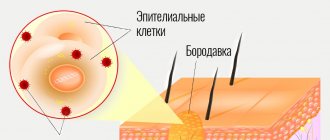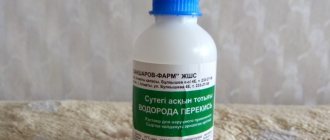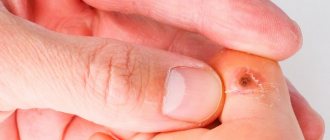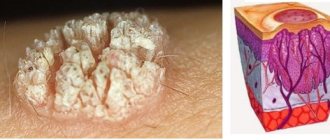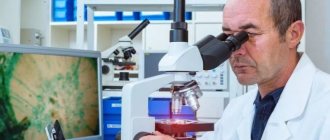Warts are a fairly common problem for many people. They arise due to the entry of the human papillomavirus into the body and are small-sized neoplasms with a keratinized crust or completely soft growths.
Most often, warts are not painful, but there are reasons why warts can cause discomfort and pain.
Pain when a wart is damaged
If the wart is inflamed and hurts, then first of all you should think about the fact that it has been damaged.
This happens most often if the formation is localized in some unfortunate place.
For example, this could be the armpit, the area under the breasts of the fair sex, etc.
The growth may be located in a seemingly problem-free place.
But at the same time, when wearing clothes, it can be influenced by friction that occurs upon contact with fabrics.
Damage to the formation is the most common cause of unpleasant symptoms.
Traumatization can be either quite pronounced, up to the appearance of blood, or weak, but systematic.
The second option is most often found during friction.
Doctors draw the attention of patients to the fact that problem areas should remove growths as early as possible.
This will help avoid their irritation and subsequent negative changes.
Also, all pathogenic growths, which are often rubbed with clothing, must be removed as early as possible.
Provided that a person does not have the opportunity to change style.
An option may be to change synthetic clothing to natural ones.
There is no guarantee that this approach will be an effective way to solve the problem.
Diagnosis of inflammation
It is not difficult to recognize inflammation, but determining the nature and cause of the disease is possible only after examination and a complete examination. For this purpose, experts prescribe a dermatoscope, which helps to examine the wart in great detail and identify all the features of its appearance.
At the same time, cytological analysis is popular in the field of diagnostics, allowing one to study the cellular structure of papilloma and determine the presence of benign and malignant formations.
After receiving all the results of the study, doctors can make an accurate diagnosis and select the most effective treatment, depending on the individual characteristics of the human body.
Malignancy of a wart
If the wart turns black and hurts, then first of all, many patients think that it has been affected by the process of malignancy.
Such concern is not unfounded.
Moreover, malignancy is the most serious reason why a patient may complain of pain in a tumor.
It is important to remember that skin cancer or, as doctors also call it, melanoma, is prone to rapid development.
In addition to its rapid development, it is also very difficult to treat.
Because of this, it is recommended to begin treatment as soon as the first signs are detected.
Doctors note that malignancy of warts rarely occurs just like that.
Often this process is facilitated by prolonged local inflammation.
Also, rubbing a wart against clothing or other parts of the body can cause a harmless growth to turn into a malignant tumor.
Ideally, patients should direct their efforts to prevent degeneration.
If the moment has already been missed, you should use the help of a dermatovenerologist.
For a complete diagnosis and selection of optimal treatment options that will help in a particular case.
Bowenoid papulosis
The cause of bowenoid papulosis is HPV types 16, 18, 31 and 33. The disease is characterized by the appearance of brownish formations on the skin of the foreskin, head and shaft of the penis in men, labia majora and minora and the clitoris in women, as well as in the groin area, perianal area and on the mucous membranes of the oral cavity. Only adults get sick. Cases of malignant transformation into squamous cell skin cancer have been reported.
Rice. 32. Bowenoid papulosis in men.
Rice. 33. Bowenoid papulosis in men. Papules are localized on the head of the penis.
Rice. 34. Bowenoid papulosis. Papilomas are located on the penis, pubic area, groin and on the skin of the thighs.
Spica: wart on the leg
If a person has a wart on his leg, it is worth thinking about such a phenomenon as a thorn.
Moreover, as noted by patients suffering from such a pathology, the pain is usually quite acute.
First, the patient loses the ability to step on his bare foot, and over time, problems with wearing shoes appear.
The spine is characterized by a very specific growth pattern.
We must not forget that it is located on the foot, and the foot, in turn, takes on the weight of the entire body during movement.
As a result, the wart is not able to grow outward, as it usually does on the fingers, armpits or other places.
It begins to slowly grow deeper, affecting the deep layers of the skin.
In this case, a small depression is formed on the surface, resembling a crater.
Interestingly, spines can grow not only on the soles, but also on other parts of the body.
It’s just that most often, due to high pressure and the impossibility of external growth, they affect the feet.
Spine, like other types of warts, can be treated, although it can be quite difficult.
In most cases, it is not possible to manage only conservative methods in the fight against this disease.
Price list for medical services of the laser surgery department
Consultation
| Name | Cost in rub. |
| Initial consultation | 2 000 |
Research
| Name | Cost in rub. |
| Cytological examination | 500 |
| Histological examination | 2 800 |
Anesthesia
| Name | Cost in rub. |
| Application anesthesia | 500 |
| Infiltration anesthesia | 500 |
| Conduction anesthesia | 1 500 |
Bandages
| Name | Cost in rub. |
| Adhesive bandage | 300 |
| Aseptic dressing | 500 |
| Bandage with medicines | 1 000 |
Removal of formations using laser radiation
| Anatomical zone | Cost in rub. for 1mm in maximum diameter |
| Scalp | 500 |
| Hands, forearms, feet, legs | 500 |
| Neck, chest, abdomen, back, armpits, shoulders, hips, crotch | 600 |
| Forehead, temporal region, ears, postauricular region | 600 |
| Eyebrows, nose, nasolabial triangle, chin, cheeks, cheekbones, red border of lips | 700 |
| Lower upper eyelids | 850 |
| Ciliary edge of the eyelids | 1 000 |
| External genitalia - single elements* *per 1 mm. 600 rub. | 1 000 |
Removal of papillomas with a diameter of up to 2.0 mm
| Name | Cost in rub. for a unit |
| Neck, chest, abdomen, back, armpits, shoulders, hips, crotch | 300 |
| Lower upper eyelids | 500 |
| Ciliary edge of the eyelids | 1 000 |
Scar treatment
| Name | Cost in rub. |
| Drug injection into the scar | 1 200 |
| Laser dermabrasion (resurfacing) per cm² | 1 200 |
Removal of vascular formations using laser radiation*
| Name | Cost in rub. |
| Photodestruction of the vessels of the wings of the nose | from 5 000 |
| Photodestruction of cheek vessels | from 10 000 |
*exact cost depends on capillary density, repeated stage of vessel destruction minus 30%
Treatment of ingrown toenails using laser radiation
| Name | Cost in rub. |
| Marginal resection of the nail plate | 6 000 |
| Removal of hypergranulations | 1 900 |
| Nail plate removal | 3 500 |
| Complex plastic surgery for ingrown toenails | 8 500 |
Removal of lipoma, atheroma
| Name | Cost in rub. |
| Lipoma removal | 18 000 |
| Removal of atheroma up to 5 mm | 6 000 |
| Removal of atheroma from 5 to 10 mm | 12 000 |
| Removal of atheroma more than 10 mm | 18 000 |
Symptoms that may accompany wart pain
Painful growth is generally not the only symptom of negative changes that a patient may complain about at an appointment with a dermatovenerologist.
Often an additional group of complaints is presented regarding the affected area of the skin.
These include:
- Inflammatory symptoms
Symptoms of inflammation most often include pain.
However, they are not limited to pain.
The patient may complain that the tumor has become red and very sensitive to touch.
In some cases, it may be noted that it has increased in size or the tissue around it has become swollen.
- Skin symptoms
Patients often feel that the wart is itchy and a pronounced burning sensation appears in the area.
These symptoms contribute to increased inflammation.
Especially if a person cannot restrain himself and combs the problem area.
- Blood discharge
Often, if the scratching is very strong, blood is released from the formation in small quantities.
If the growth is very severely injured, the bleeding may be noticeable, and sometimes medical assistance is required to stop it.
Zolotov Sergey Alexandrovich
- Candidate of Medical Sciences, surgeon, specialist in laser surgery.
- From 2003 to 2009 completed training at the State Budgetary Educational Institution of Higher Professional Education "Russian National Research Medical University" named after. N.I.Pirogov Ministry of Health of Russia.
- From 2009 to 2011, he completed his residency at the Moscow State Budgetary Healthcare Institution, Research Institute of Emergency Pediatric Surgery and Traumatology, specializing in Pediatric Surgery.
- In 2011, he completed training under the program of additional professional education of doctors in laser medicine at the State Scientific Center for Laser Medicine of the Federal Medical and Biological Agency of Russia. From 2011 to 2014, he studied full-time graduate school at the Moscow State Budgetary Healthcare Institution Research Institute of Emergency Pediatric Surgery and Traumatology.
He has extensive experience in removing various benign formations of the skin and subcutaneous tissue using laser surgical methods.
More than 5 years of experience in surgery.
Pain after fighting warts
If a person has pain after removing a wart, this is not a reason to be surprised or worried.
The fact is that mild pain is a normal reaction of the body to contact with caustic substances that are used to get rid of growth.
On average, as doctors note, the pain goes away after a few days.
Warts hurt after nitrogen, laser, or using celandine.
Often, unpleasant sensations are a consequence of inaccurate application of the medicinal substance.
Because of this, the skin unaffected by the virus was damaged.
However, even if the substance is applied perfectly, or the laser beam is aimed perfectly, pain may be present.
We must not forget that after the growth falls off, a small skin defect will form in its place.
It is he, and not the pathogenic neoplasm itself, that will cause pain to the patient.
However, as doctors note, such defects heal quite quickly without any traces.
Especially if the growth was initially small in size.
As soon as the skin heals, the pain will disappear.
The main thing is to ensure proper skin care during this period.
Epidemiology
Viral warts are quite widespread in the human population. Up to 45% of people are carriers of the infection without visible manifestations on the skin. Clinical manifestations of warts are recorded in 10% of children and adolescents and 30% of adults.
HPV in case of warts enters the human body through household contact, and in the case of condylomas, through sexual contact. The risk of infection depends on the site of entry of the pathogen, the viral load, the degree and nature of contacts, and the person’s immune status. The spread of infection on the skin is facilitated by scratching, scratching, abrasions and the habit of biting nails. Familial cases of the disease and outbreaks of infection among schoolchildren are often observed. For some time, viruses remain viable in toilets, baths, swimming pools and gyms. A certain role is assigned to the state of the nervous system.
HPV infection with condylomas is transmitted during sexual intercourse. Microtrauma and the inflammatory process, often associated with sexually transmitted infections, contribute to the spread of viruses. The peak age of HPV infection is between 18 and 25 years of age. It is noted that carriers of pathogens are more often men. Women in the process of promiscuity can acquire a whole bunch of different types of HPV.
Rice. 4. The photo shows warts on the hands.
A wart hurts, what should I do?
Patients often ask doctors about what to do if a wart hurts.
Any competent dermatovenerologist will tell you that if pain occurs, you should immediately consult a doctor.
At the appointment, the doctor will be able to decide what the cause of the pain is, and also choose the best option to eliminate it.
Moreover, in some cases the growth will have to be removed, in some cases the clothing habits will have to be changed.
And in some cases you simply use light ointments to care for the defect (for example, Fenistil to eliminate itching, etc.).
The decision on tactics is made in each individual case individually.
If a wart hurts after celandine or other removal products, it is important to properly care for the injured skin.
First of all, the patient is recommended to treat the affected area with iodine or another antiseptic substance.
You can also apply a bandage or adhesive tape to the wound.
This will prevent pathogenic microorganisms from entering it.
If the pain cannot be relieved for a long time, it is worth visiting a doctor for consultation and deciding what to do next.
Stages of prevention
It is easier to prevent the occurrence of warts than to remove them later. There are certain points that you should pay attention to in order to avoid illness.
Measures:
- Strengthen your immune system, take vitamins,
- Follow the rules of hygiene,
- To refuse from bad habits,
- Review your diet, eat more healthy foods,
- Lead a healthy lifestyle,
- Limit contact with infected people.
Removing a wart can be difficult. Often the reasons lie inside the human body. You should not self-medicate, as this can lead to negative consequences. Do not forget that such neoplasms can develop into oncology.
What complications can you encounter if you don’t visit a doctor if you have wart pain?
If the wart hurts and grows, or other negative changes occur with it, you should be prepared to encounter dangerous complications.
First of all, as doctors say, the threat is infection.
Often it penetrates the wart if it has been injured to the point of bleeding or the patient has scratched it.
Pathogenic microorganisms begin to actively multiply in damaged tissues.
Only increasing pain, itching and burning.
In most cases, even if infection cannot be prevented, it resolves quite easily.
However, with a strong decrease in the body’s immunity, a whole range of unpleasant consequences is possible.
Up to the point of ending up in intensive care.
Another dangerous complication is malignancy or, as they also say, malignant degeneration of the tumor.
As soon as the growth turns into a full-fledged tumor, it begins to gradually destroy the surrounding tissue and metastasize.
As a result, health damage can be irreparable.
And changes in the body, if no measures are taken in a timely manner, are lethal.
Complications of the human papillomavirus are often much more dangerous than the virus itself.
Clinical manifestations and types of HPV
HPVs have tissue specificity—certain types of viruses infect tissues specific to their localization. ICD-10 code: B07.
| Clinical forms | HPV types | |||
| Group of non-oncogenic (not causing malignant transformation) HPV | ||||
| 1 | Warts vulgaris | More often 1, 2, 3, 4, 27 and 57. Less often - 5, 7, 10, 26, 28, 29, 38, 41, 48, 49, 60, 63, 65,75 - 77 | ||
| Filiform | 3, 5 and 9 | |||
| Flat (youth) | More often 3 and 5, less often - 10, 27, 28, 30, 41, 49 and 75 | |||
| Butcher's warts | 7 and 27 | |||
| Cystic | 60 | |||
| Mosaic | ||||
| 2 | Focal epithelial hyperplasia | 13, 32 | ||
| Group of low-grade oncogenic HPVs | ||||
| 5, 6, 7, 8, 11, 12, 14, 15, 17, 19, 20, 21, 22, 23, 24, 25, 42, 43, 44 | ||||
| 1 | Condylomas acuminata | In 90% of cases, types 5, 6 and 11 | ||
| 2 | Epidermodysplasia verruciformis | 5, 8, 9, 10, 12, 14, 15, 17, 19, 20 — 23, 24, 25, 36, 39, 40, 47 | ||
| 3 | Laryngeal papilomatosis | 6, 11, 30 | ||
| 4 | Giant Buschke-Levenshtein condyloma | 6 and 11 | ||
| Group of oncogenic HPVs with a high degree of malignancy | ||||
| 6, 11, 16, 18, 30-31, 33, 39-40, 42-43, 51-52, 55, 57, 61-62, 64, 67 | ||||
| 1. | Bowenoid papulosis | 16, 18, 31 and 33 | ||
| 2. | Flat condylomas and cervical dysplasia | 6, 11, 16, 18, 30-31, 33, 39-40, 42-43, 51-52, 55, 57, 61-62, 64, 67 | ||
Rice. 3. Warts vulgar (left), filiform (center) and flat (right).
